

Editor’s note: Greg’s father, Sgt Hyman Hatton, 576th, became a POW on 29 Apr 1944. Greg has spent decades looking for “the stories my father never told me.” In the process, he has become knowledgeable on the subject of POWs in Europe. In this article, he examines books and manuscripts in his collection that are by or about 392nd BG POWs.
The combat diary is a familiar format for writing about the experience of war. Six former Crusaders who were prisoners of war have had their personal accounts published. Writing about events allowed these airmen to concentrate and regain focus after missions or to endure their difficult days of captivity. Recalling those days allowed them to expand their perspectives on the events they were part of.
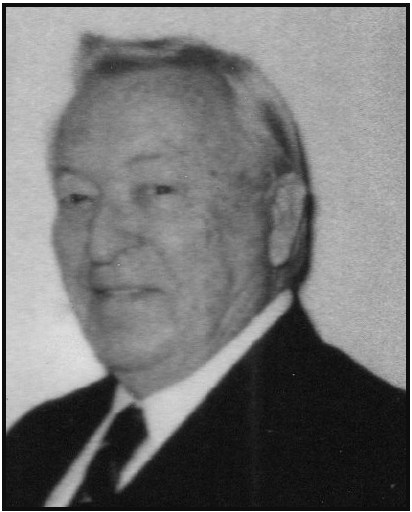
Sgt Richard H. Hoffman
Richard H. Hoffman (LtCol, Ret.) flew in the early days of combat, during the fall of 1943. The ball turret gunner on the Nicholson crew (579th), he went down in Georgie Belle on November 5. Stalag 17b: Prisoner of War (Xlibris Corp., 1988) is an accurate portrayal of the people and events taking place in the prison camp made famous by Hollywood. It’s evident that training acquired as an intelligence officer and historian later in his Air Force career was put to good use while writing this book.
The first chapter recounts his final mission and subsequent capture. However, Hoffman’s well-crafted stories focus mainly on the 18 months he spent at the camp for enlisted airmen in Krems, Austria. The American sergeants had arrived only weeks before him, so he was part of the early efforts to organize and cope with their ruthless German captors. Stalag 17b was limited in size, so the camp population remained under 5000 men. Hoffman's stories underscore how skilled airmen, held in tight quarters, survived.
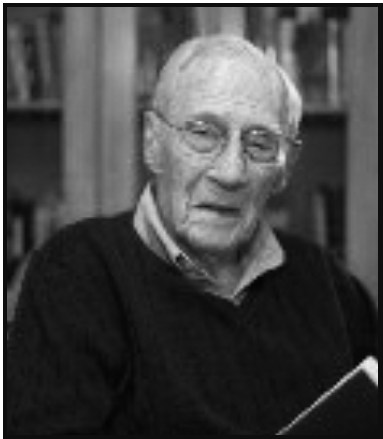
2/Lt Jack H. Adams
The Lamma crew (577th) arrived at Wendling after flying 800 hours of sub patrol over the North Atlantic (thereby giving them credit for completing 12 to 16 combat missions). They seemed well on their way to completing their combat tour. However, on November 13, 1943, after only two missions with the 392nd, 2/Lt Jack Adams was shot down. Fighters attacked Mac’s Sack 2 before it reached the target.
Written in association with Ann Moore, Lest We Forget: A Navigator’s Tale (self-published, 2013), is dedicated to the generation of airmen with whom Adams served. Although 100 pages are devoted to reprinting his elaborate “POW Wartime Log,” life at Stalag Luft 1 is not his primary focus. Well-educated and reflective, Adams reveals himself through relationships with men and women who were part of his wartime years.
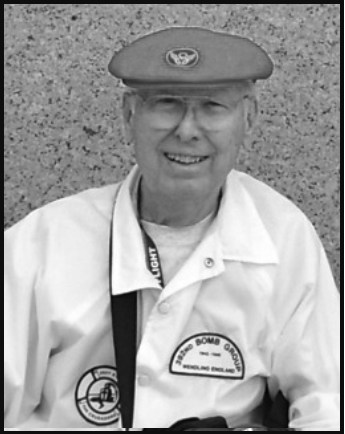
T/Sgt Robert D. Davis
In 2005, after a career in metallurgy, Robert Davis tackled a biography, Growing Up—And Then Some! Focused on his youth in Springfield, Ohio, it was about growing up during the Depression. Davis included chapters about the Eisermann crew and his life after the War. His daughter persuaded him to write about that experience in more detail. The result was Before I Forget (AuthorHouse 2011). I’m no longer touting total recall; I might even be given to a little exaggeration… but I’ll try not to distort things.
His crew departed for England on February 12, 1944, taking the southern route. The first of twelve missions began on April 10. Flying a variety of 578th planes, including Jaw Ja Boy and Pallas Athene, his career as a radio operator ended abruptly on May 29. All the enlisted crewmen were sent to Stalag Luft 4. After eight months in captivity, they became part of the evacuation across Germany know as the Long March.
Davis’s memories are pithy and colorful. After ferrying their B-24 to the replacement depot at Stone, the crew made their way to Crumlin, Northern Ireland. Entering his first pub, he ordered a Bushmills because I had heard my brother Dan talk about it. I took one sip of this Irish whiskey, the train whistle blew —fortunately—and I went back to the train. Irish whiskey is an acquired taste. I did persist. And persist. It took years. It was acquired.
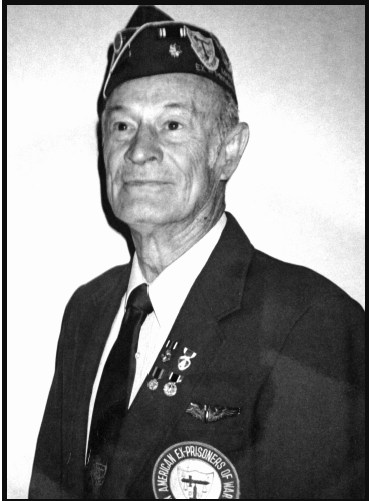
1/Lt H. Everett Thomas
It’s been said that even though your skills improved, your odds of surviving combat didn’t change much. H. Everett Thomas (LtCol, Ret.), bombardier on the Jones crew, proves the point. The complete title of his memoir is 33 Heavy Bomber Missions with the 576th Sq., 392nd BG, 2nd Air Division, 8th Air Force And Then 10 Months in Stalag Luft 3, Forced March, Box Car Ride and Stalag 7a (self-published, 1993). It’s a chronicle of his path from Cadet training to Tucson, where so many 392nd crews were formed, and then onward. On July 7, 1944, he heard those familiar words: For You the War is Over!
It’s almost unbelievable, and a bit eerie to sit here a half century later to write and assemble my diary, histories and memoirs into a book called 33 and Then 10. The entry into service, the training, the actual combat, life in POW camps, the forced march, the boxcar rides between camps and life after liberation is a story to tell… I shiver at times when I recall the lonely, isolated feeling up in the nose turret when we were under fighter attack. Lying down on the floor of a boxcar was impossible, except for a few moments; we were stacked like matches... Being liberated and knowing after all this time you would be heading home soon was great for me... [These things] made me learn the value of life itself... and to appreciate freedom...
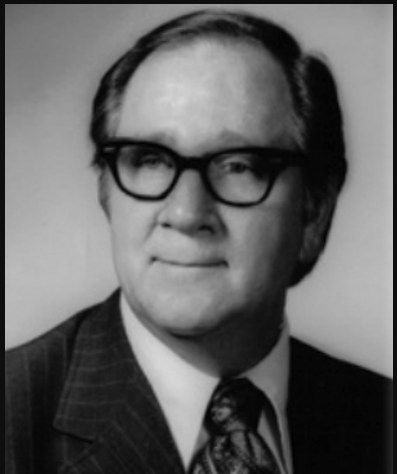
S/Sgt Odell Dobson
Mission #166 was on September 11, 1944. Five planes and aircrews were lost. Fighters attacked Ford’s Folly; waist gunner S/Sgt Odell Dobson and radio operator T/Sgt Roger Clapp Jr. were the only survivors from the Rudd crew (578th). Severely injured, Dobson was in German hospitals for weeks before being sent to Stalag Luft 4.
While on vacation in Spain many years later, Dobson met BBC broadcaster Bruce Lewis. Lewis had been an RAF flier and was assembling the material for Four Men Went to War (St. Martin’s Press, 1989). Dobson was primed and ready for that meeting. Active with both the 392nd BGMA and American Ex-Prisoners of War, he was part of the process where vets were weaving together pieces of their common memory.
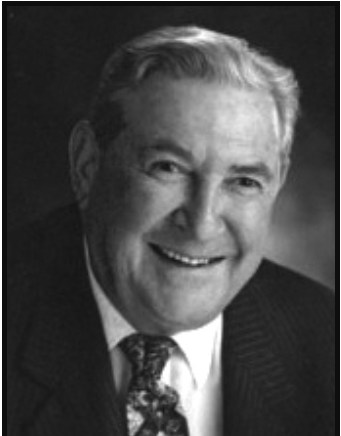
1/Lt Coleman Jacobson
On the same mission as Ford’s Folly, Lady Diana (579th) took a direct hit by flak. Fortunately, the entire Haines crew managed to bail out. Bombardier Coleman Jacobson was captured and spent eight months at Luft 1 in Barth, Germany.
Lt Jacobson went on to medical school and eventually established himself in Dallas. Like Dobson, he was caught up in the wave of POW re-connections. That placed him squarely in the path of a remarkable effort by a former 8th AF POW from North Dakota. Elmer Lian was videotaping scores of men through the auspices of the University of North Dakota. Jacobson eventually met author Erik Dyreborg in Copenhagen. Aside from his insightful narrative about camp life, Jacobson’s contribution to The Captured Ones: American Prisoners of War in Germany 1944-1945 (iUniverse, 2006) includes unique photos he took of the camp after liberation.
Oberursal
The center for an airman’s interrogation was initially situated just outside of Nuremburg, in Oberursal. Dulag Luft was staffed by hand-picked intelligence personnel. The techniques devised by Hans Scharff are legendary among Allied airmen and historians. After capture, the prisoners were quickly transported to the facility in order to take advantage of their disorientation after combat. Placed in a cramped, dark cell with little food or water, airmen were then subjected to a series of interrogations designed to coerce seemingly innocent bits of information. Lt Jack Adams speaks for the thousands who shared that experience:
To describe the time I spent in solitary confinement as a black hole is to say it all... I vividly recall having been [there] for two weeks... it was extremely strange to find myself being held so tightly under someone else’s control. Not only was I unable to leave the tiny cell more than a few times a day... but during that time no conversation whatsoever was allowed... One day blurred into another with unbroken similarity, enough to unnerve a strong man… During the interrogation process I was strongly aware of how effective solitary confinement was in developing an urge to talk once there was an opportunity…
There was a unanimous feeling among those going through the process that the collection of personal data from public sources in the United States was a very effective tool in convincing prisoners that there was no point in trying to withhold information... it had a jarring impact when, as POWs, we heard all about ourselves from the enemy… For Sgt Hoffman, captured only a few days before, that interview process took a surprising turn:
“You don’t have to tell me anything! I already know all about you.” He reached under the desk and pulled out a red leather-bound book. Gold lettering on the cover spelled out “392nd Bomb Group.” He pulled out a second red leather book and waved it. “This is your squadron’s. We know everything.” The German recited all kinds of information about the group, starting from the day it arrived in England. He named people and their jobs, then flipped the group book open and turned it around. “This is a picture of your bomb dump, isn’t it?” I ... didn’t know whether it was or not. “Why ask me if you know all the answers?” “Oh, just to confirm it. What were the radio call letters for today? What was your crew position?” …
An answer would have confirmed my group connection. The interrogator kept on with the questions and started to become abrasive. He insisted that I answer him. I was fed up with the entire process and decided to ask some questions of my own... “Do you really believe that Germany will win the war?” “There is no question about that! We will win the war!” he growled. “Do the Russians really tie your solders to their tank treads and run them over?”
The interrogator slammed his fists down on the desk and leaped to his feet in a rage. His chair flew back and crashed against the wall... His violent reaction had startled and frightened me... The German calmed down and asked more questions, but I stopped him. “Surely you must realize that I cannot answer your questions… under similar circumstances, you would feel the same way.”
...A moment later someone knocked on the door. [He] held out a pack of cigarettes to me. It was a friendly pose. … A guard escorted an RAF airman into the room. The interrogator’s face turned red …then he yelled at the guard. From what I could understand, he had brought in an airman with the same name as my tail gunner. I’d been set up to make Pappy think that I had cooperated with them.”
On the Train and POW Life
By the time of Sgt Davis’s capture, the process for airmen had become somewhat abbreviated. After interrogation, Allied airmen stayed at the adjacent transit camp, now in Wetzlar. Within a few days, most enlisted men departed for Stalag Luft 6 in what is now Lithuania, Stalag Luft 4 in Poland or Stalag 17b in Austria. Looking back on that journey, Davis tells what he found in his new camp:
They took away all our flying clothes and gave us regular GI olive drab uniforms. The shoes, however, were poorly made; very stiff, ankle-high, lace-ups. There must have been two or three hundred of us put into boxcars and shipped out of Wetzlar. I exchanged glances with Lt Eisermann in the courtyard just before we left for the train. Still going by the rules—don’t recognize your fellow crew member.
Our destination was Stalag Luft 4...close to the Baltic Sea… about five hundred miles. They packed us in… with [little] food or water. Somewhere during the trip, they stopped... to let us out of the cars to relieve ourselves. For many, it was too late—which hadn’t helped the environment in the boxcars. The train tracks were built upon a high, grass-covered embankment… there was a desperate rush of bodies to get outside and soon there was a large number of bare bottoms decorating the embankment. One of the German non-coms, an obvious wit, yelled out: “Ein, zwie, drei….schizzen.”
...we arrived at Stalag Luft 4 close to the middle of June. It was a typical camp… with double rows of very high barbed wire and guard towers with machine guns all around and in between the lagers… Inside the barbed wire, at a distance of some ten yards or so, was a white wooden fence… if you stepped over the fence for any reason, you would be shot...
Each barracks, ten per compound with twenty rooms in each, initially housed sixteen men per room although that number steadily increased as the war went on. The bunks had wooden slats and straw mattresses... an inch thick [that] hung down between the slats. The technique for sleeping was to keep one slat under your feet, one or two if you had them under your butt, one or two under your shoulders and the last under your head and neck.
...During the summer months, most of us just wore our underwear shorts outside. That helped with the lice, but then we were exposed to the sand fleas. When it got cooler, the lice... would get into the seams of your clothes, and as soon as your body heat had warmed them up enough, they would start to move. You would try to catch them and crush them with your fingernails, but you couldn’t win, for there was always one more crawling around your body somewhere. I would no more than get comfortable on the slats—and did I say comfortable?—than the lice would start to move—and continue to do so all through the night.
In early July, several of us caught diphtheria We were put into quarantine in one room… I can still remember the rasping sound of our breathing—or trying to breathe. .. After ten days, they finally got some serum to us... When we were well, they released us from quarantine in the shuttered-up barracks room. They neglected to tell us to protect our eyes from the sunlight for at least two weeks… so my 20/15 vision went bye-bye.
Lt Harry Thomas speaks through his combat diary entries until he begins to write about his confinement at Stalag Luft 3. This is the camp of “Great Escape” fame.
Enlisted men voted for “the Man of Confidence” who managed affairs within the camp and negotiated with the Germans for compliance with the Geneva Conventions. Officers’ camps maintained the “chain of command.”
I guess maintaining a rather decent semblance of military life was our biggest asset… officers like Vanaman, Spivey and Goodrich are due a tremendous note of thanks for their sacrifices and contributions. Chain of command worked. Block commanders had their share of responsibilities and true to life, some did great and some did not…
The bread ration per week was one loaf. The loaves were heavy, over 2 pounds, probably due to a good part of the bread being sawdust. Blood sausage was not eaten by many of the POWs. I didn’t like it worth a damn but I ate it! When we did get a few ounces of meat, it was usually bad, but edible. About the last of August,… we started receiving only one half Red Cross food parcel per week.
Cooking was a hurry up deal for everyone. Each combine had so much time allotted to cook the meal for their “family” back in the combine. Only about a half hour was given to each group.
This is not reported, but it happened a lot. Good friends for months in close confines of the camp would start quarrelling and ended up blowing to pieces and being on the verge of fighting over very small and insignificant disagreements. We were all lonely, homesick, unhappy and tired of our life… it’s a wonder we all got along as well as we did for so long. My mail call from July 1944 until June 1945 was zero. Not even a postcard did I receive the entire time I was captured.”
The Long March Morale in the camps after D-Day was buoyed by the thought that the Allies were winning and that the Kriegies [short for kriegsgefangener, the German word for POW] might soon be liberated. Eight months later, in the middle of the coldest winter on record, the fragile illusion of security slipped away. Except for Stalag Luft 1, prisoners in all the camps in Germany were forced to begin marching west, away from the approaching Russian army.
Bruce Lewis, who tells S/Sgt Odell Dobson’s story, describes the events of February 5, 1945: “The kriegies in Stalag Luft 4 could hear the sound of exploding shells as the Russian military opened up nearby… There was a great deal of speculation among the flyers… could this mean that they were to be free at last… Thinking that tomorrow might be an important day, Odell went to bed early. At daylight, the POWs were paraded in the compound. They were told that they were to move to Stargard, 150 kilometers to the west and they must be ready to march at once. It took Odell no time at all to collect his possessions: a toothbrush and a deck of cards. For good measure, he grabbed two Red Cross food parcels and slung them round his neck. Hurriedly, the men were marched out of the camp under heavy guard… Odell was near the front of his particular column of 300 men…. So, in near arctic conditions, Odell and his companions became part of the mass trek westward… it involved a significant portion of the population of central Europe to which POWs added their numbers.
Odell’s first reaction was a feeling of exhilaration at being freed from the confines of the camp. Although it was bitterly cold, the kriegies were walking at a brisk pace. They had parcels of food... enough to last them until they reached their destination in about four days time. They were able to enjoy those first few hours as their column moved steadily through the forest. If they had known what lay ahead of them, their good spirits would have drained away like melting snow. They would have found it inconceivable that eighty days later, they would still be trudging wearily on.
Stalag 17b had its own march. In early April 1945, the POWs encountered two or three hundred Jews and political prisoners being marched away from Mauthausen concentration camp. SS guards killed at least twenty-two of them as the POWs looked on in horror. Hoffman wrote, The Twenty-Third Psalm rushed to my mind, and I prayed hard. If ever there was a Valley of Death, we were in it.
Stalag Luft 1
The vagaries of war placed two young men from New Haven, Connecticut, into the bombers of the 392nd and then into the barracks of Stalag Luft 1. Coleman Jacobson became a POW a year after Jack Adams but was separated by time and place. They were, however, both part of the uncertain days at Barth in 1945.
We did have a radio… We were getting the BBC every night. Somebody would write out the salient headlines and they were distributed in some surreptitious fashion so each barracks got it. At nighttime, when the lights went out, this was passed around and we talked about where the lines were. It got to be pretty exciting after October of 1944 as the Allies advanced.
Up north, where we were, there wasn’t a great deal of military activity. There wasn’t any place to move the POWs. They were moving… the other camps west. The Germans seemed to want to hold onto prisoners for political reasons… there was some question of what would happen to American POWs if the Russians liberated us and we were put under the control of a Russian commander. That did eventually happen. We stayed at Stalag Luft 1 for quite some time into May until we were evacuated. The rumor was that they would take us into Russia then send us back to the Black Sea. We had no way of knowing.
So, everybody was planning to evacuate the camp by Christmas. Someone made a bet that we would be out of camp by December 25th; if we weren’t, he would kiss the guy’s ass in front of everybody at Appell [roll call] one morning. We were still there, so sure enough, the winner pulled down his britches and the loser kissed him right in the place where he said he would…. it was a source of great laughter for us but great consternation to the Germans.
[Morale] took a turn for the worse when things got good for the Germans... soon after, our Red Cross parcels abruptly stopped. The Germans told us that they didn’t have any more because [the packages] weren’t getting through. This sounded plausible, but it was a big lie… after they evacuated the area in the beginning of May, we ransacked their supplies…. They had tons of Red Cross food... as well as shoes and overcoats which we never got...
When we awoke on the morning of May 1, we realized that for us, the war was over. The guard towers were empty; there were no Germans around, everybody had disappeared. [POW commander] Colonel Zemke put his own people in charge in each of the compounds, with strict orders that nobody was to be leaving the camp and order was to be maintained. As far as I was concerned, as soon as I had word there were no Germans in the area, I disappeared out of North 2 compound and on to the road to Barth. There I obtained three cameras, film and some other contraband. I returned to the camp and began taking pictures of the camp and as many individuals as I could get together.
On the afternoon of May 3, something remarkable happened. A few Russians came into the camp. One of them, a Russian Colonel, was riding a horse and was stinking drunk from vodka. He had a pistol in his hand and was shouting. He wanted to know why we weren’t breaking windows, burning down the barracks and going into town to do all the things good soldiers are supposed to do. He did convince Colonel Zemke [to loosen up]… this let out a bit of pent up energy… some of the Texas boys were able to round up a couple of cows… so they were making steaks on a spit for the evening meal…
I was getting a little impatient… I was going to try to get out on my own. I still have the pass, written in Russian, saying that I was an American from Barth prison camp and was to be given whatever help necessary. [After several days]… we got to the British lines on the Elbe River… [and from there to Paris and home].
Editor’s note: The photos of the former POWs are courtesy of Robert Davis, Richard Hoffman’s book cover, Kyle Weinstein (Jacobson), Marsha Emanuel (Thomas), Michael Dobson (Odell), and Ann Moore (Adams).